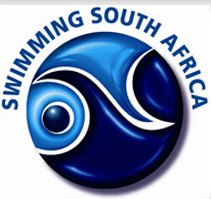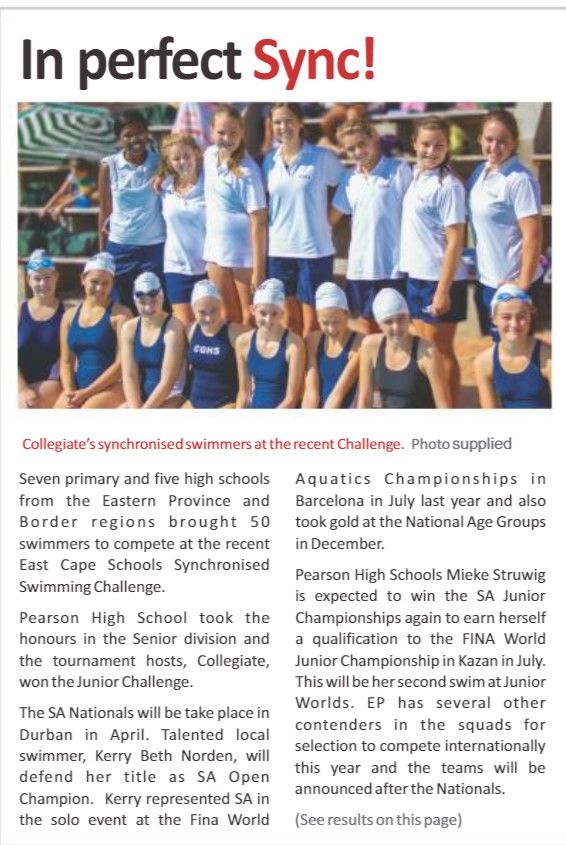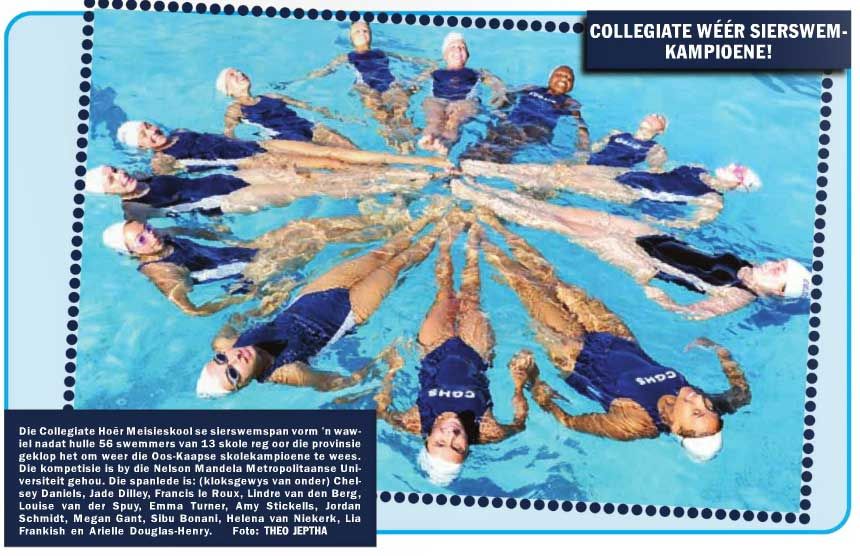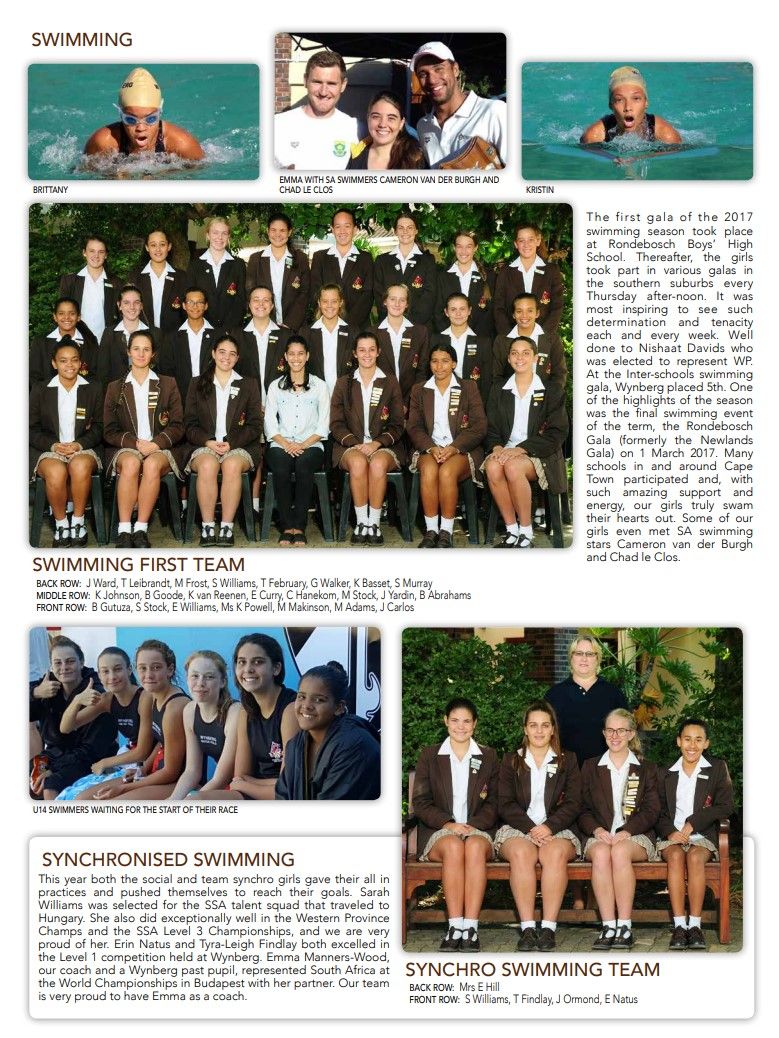Synchronised Swimming
aka Artistic Swimming
aka Artistic Swimming
The sport developed in the United States in the 1930s. The sport’s governing body replaced the name synchronized swimming with artistic swimming in 2017. FINA first recognized synchronized swimming in 1954. Swimmers in solo, duet, or team (four to eight persons) competition.
Together with swimming, diving and water polo, synchronized swimming became the fourth sporting code to participate in the annual aquatic championships organized by the national governing body, then known as the South African Amateur Swimming Union (SAASU).
In 1972 South Africa was one of 14 countries that held a national Championships for synchronised swimming.
Until the 1992 Olympic Games when South Africans were again allowed to compete in international sports, South African synchronised swimmers were mostly limited to annual competitions against their Rhodesian neighbours between 1974 and 1980. Five swimmers were awarded Springbok colours in 1974, including sisters Colleen and Wendy Davies and Beverley and Aileen Martin, and also Karen Edmunds.
The Davies sisters again swam for South Africa against Rhodesia in 1975, with Lyle Walsh, Sandra Clokie and Jane Hart. In 1976 Tanya Mansfield was selected with Sandra Clokie, Lyle Walsh, Jane Hart and Colleen Davies. In 1977 no synchro team seems to have been selected for the Tests against Rhodesia. In 1978 Clokie, Mansfield and Hart were joined by Allison Gittings and Allison Blackbeard - a sister of international superstar swimmer Paul Blackbeard. In 1979 Sandra Clokie, Allison Blackbeard and Allison Gittings joined Kerry Woodhead and Susan Scott for the annual showdown against the Rhodesians. The same five swimmers were selected for the last Test against Rhodesia held in Cape Town in 1980.
Amanda Taylor and Lauren Wulhsohn were selected to compete at the 1992 Olympic Games. In 2021 Clarissa Johnston and Laura Stugnell swam at the Tokyo Olympic Games.
Clarissa Johnston and Laura Strugnell from South Africa were equally excited. The two were simply happy to even be there and to finally showcase their routines. They barely held back tears after scoring above 70 in both of their routines, which was their main goal at these Olympics. Since the 2019 World Championships, the country has improved by 5.4 points in tech and 4.8 in free.
In 1994 Renáta Pešlová competed at the Commonwealth Games and the FINA World Championships.
Nine swimmers went to the 7th FINA World Championships held in Italy in 1994, and 8 went to the next FINA Championships in 1998.
Judie-Ann van Niekerk was the only synchro swimmer to compete in the 9th FINA Championships held in Japan in 2001, and the 2002 Commonwealth Games in Manchester.
After 1992 the various sporting codes started to organize their own annual championships after the traditional provincial system has been disbanded to be replaced by a club-based one, managed by Swimming South Africa. Currently, the sport competes at Novice, 12&Under, Youth and Junior Solo champions and the Novice, Youth and Senior Duet champions across both SA National Age Group and SA Nationals. Some male athletes and mixed duet are competing at SA Nationals level.
In Cape Town the Baracuda SC is run by Sue and Emma Manners-Wood - click here to see their website.
The Aquanova SC is based in East London. In Port Elizabeth Moira Norden now manages the Aquabear SC synchro division. Kingfisher AquaSync Artistic Swimming Club is based in Pretoria, while Team Phoenix is a Johannesburg club. .
Other clubs include the Umlazi Sharks Aquactic Club in Durban, and Cosmo Dolphins in Roodepoort. Some schools also have synchro as a school sport. These include Collegiate in Port Elizabeth, Wynberg in Cape Town and Kingsmead in Johannesburg.
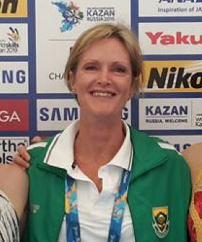
coach Sue Manners-Wood
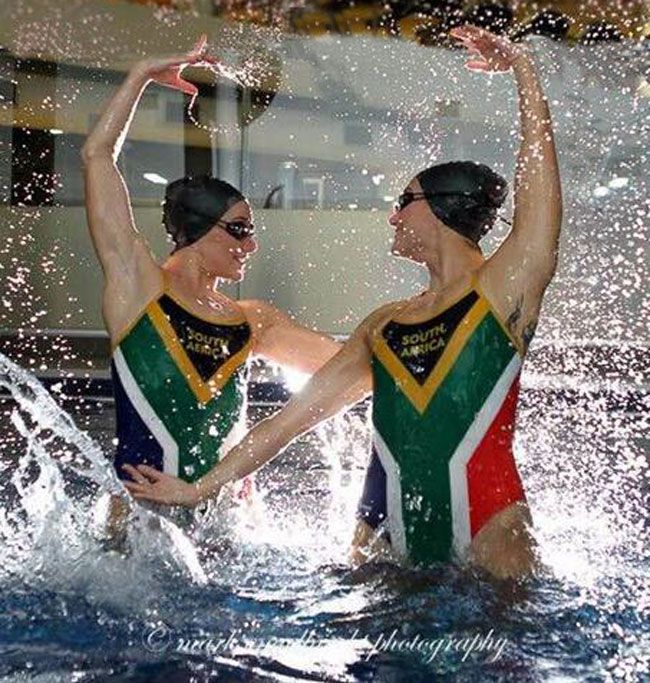
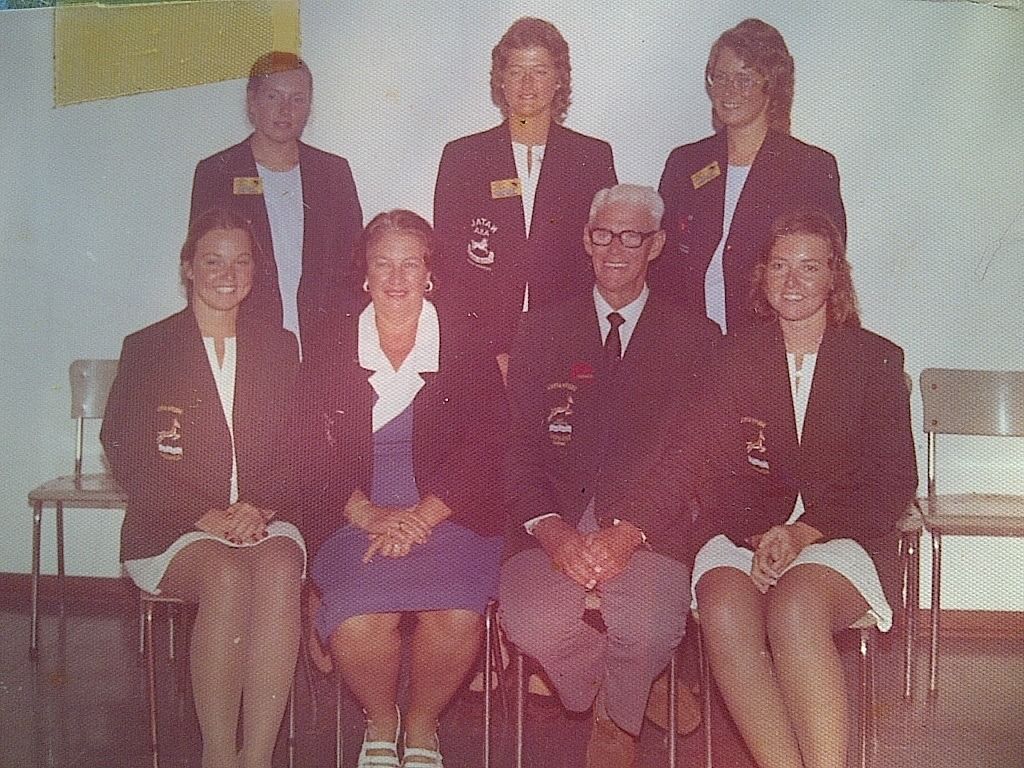
1975 Springbok Synchronised Swimming Team with manager Vic Myburgh and coach Dot Schoombie.
SYNCHRONISED SWIMMING by Elaine Buck - 1973
Synchronised Swimming is a comparatively new sport in South Africa, but has been swum competitively in other countries since 1945. Basically, Synchronised Swimming is the performance of aquatic movement by one or more performers, synchronised to a musical accompaniment and each other. Many people argue as to whether Synchronised Swimming is an art or a skill. It is a skilful art, requiring a good sense of balance, rhythm, endurance and physical fitness. Synchronised Swimming can be divided into two parts — Stunts and Routines, and mastery of both is essential for the good Synchro girl.
A Synchro swimmer's life revolves around the Stunts, which are all laid down in the F.I.N.A. Handbook, as until these can be mastered, progression to routines is both useless and undesirable. When it is fully understood that the marks earned in the Stunt competition or championship are carried to all routines performed, it will be appreciated why the correct performance of stunts is so important. The term "Stunts", may be a misnomer, giving the uninitiated the idea of a circus performer. A more suitable term would probably be Aqua Gymnas- tics, or even Aquabatics. To perform stunts, swimmers must have above average muscle control, the ability to gauge distance and direction under-water with eyes open while the body is performing intricate and difficult movements, tremendous breath control (some stunts can take up to 17 seconds under water when performed by a skilled synchro girl), and the strength of arms to support the weight of the body.
To anyone who suffers claustrophobia when submerged, Synchro would be impossible. Constant exercise of the correct muscles is necessary during the winter months, both to keep the body supple and strengthen the muscles, and special exercises have been devised to meet the needs of Synchronised Swimmers. After an off-season break, it is necessary for a Synchro swimmer to build up stamina in the water by daily training, which comprises swimming of all strokes, and sculling. For the top performer, a minimum of 1,000 yards a day is necessary, until stamina has been resumed, when an hour of stunt practice daily is necessary.
These stunts are highly technical in detail, and deficiencies are not always noticeable to the untutored eye. Infinite patience is needed by coach and competitor, if all phases of the stunts are to be done correctly, and together with Judges, a high degree of knowledge of the basic positions is essential to all. Routines are a completely different type of challenge. A Synchro girl can have tremendous skill in stunts, and be completely unable to swim a routine with grace and in time to music. The reverse can also apply, of course, and it is to blend these two different skills into a perfect whole, that is the airy of every coach and swimmer.
The full report (below) is from the 1973 SAASU Annual Report.
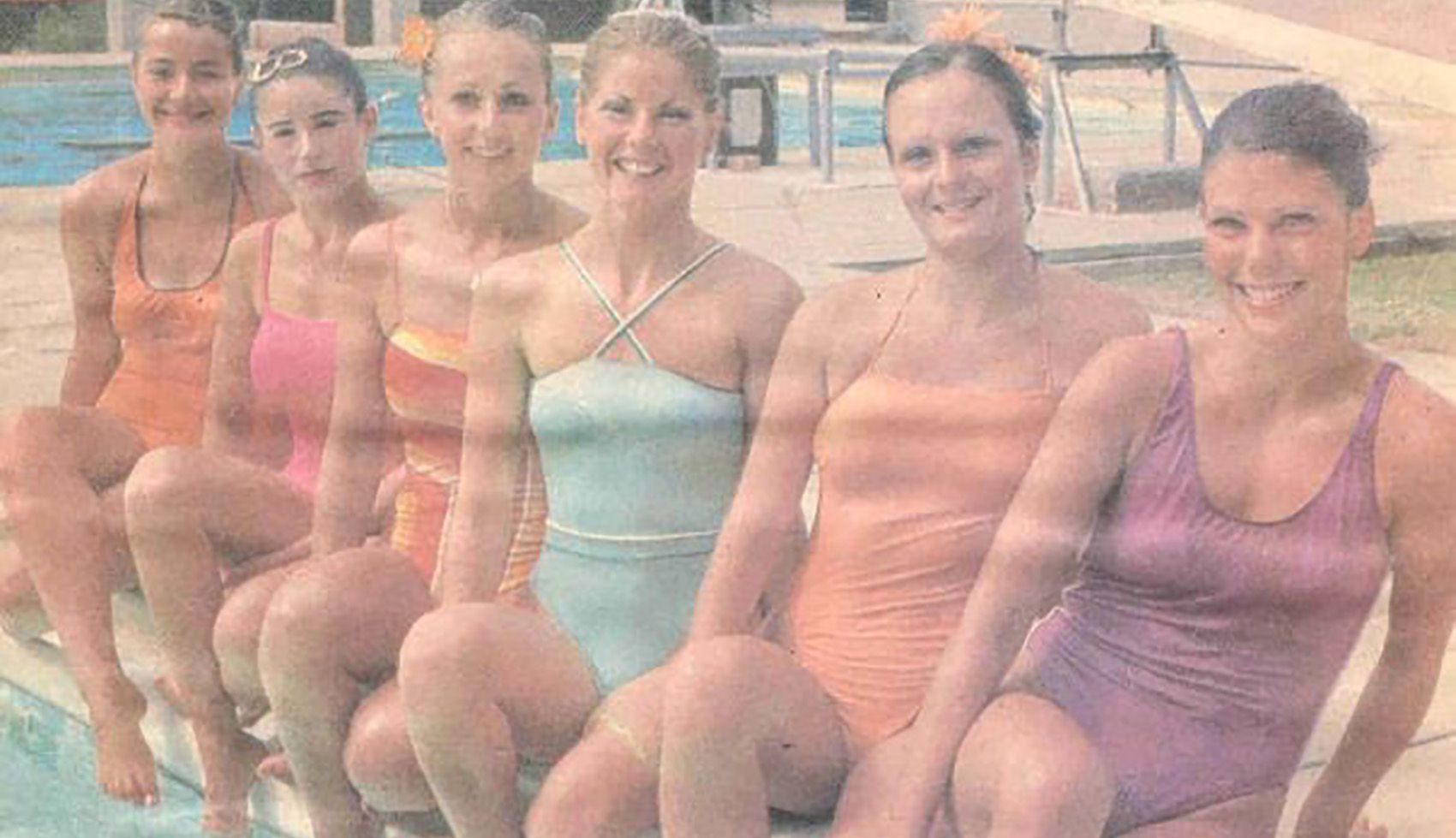
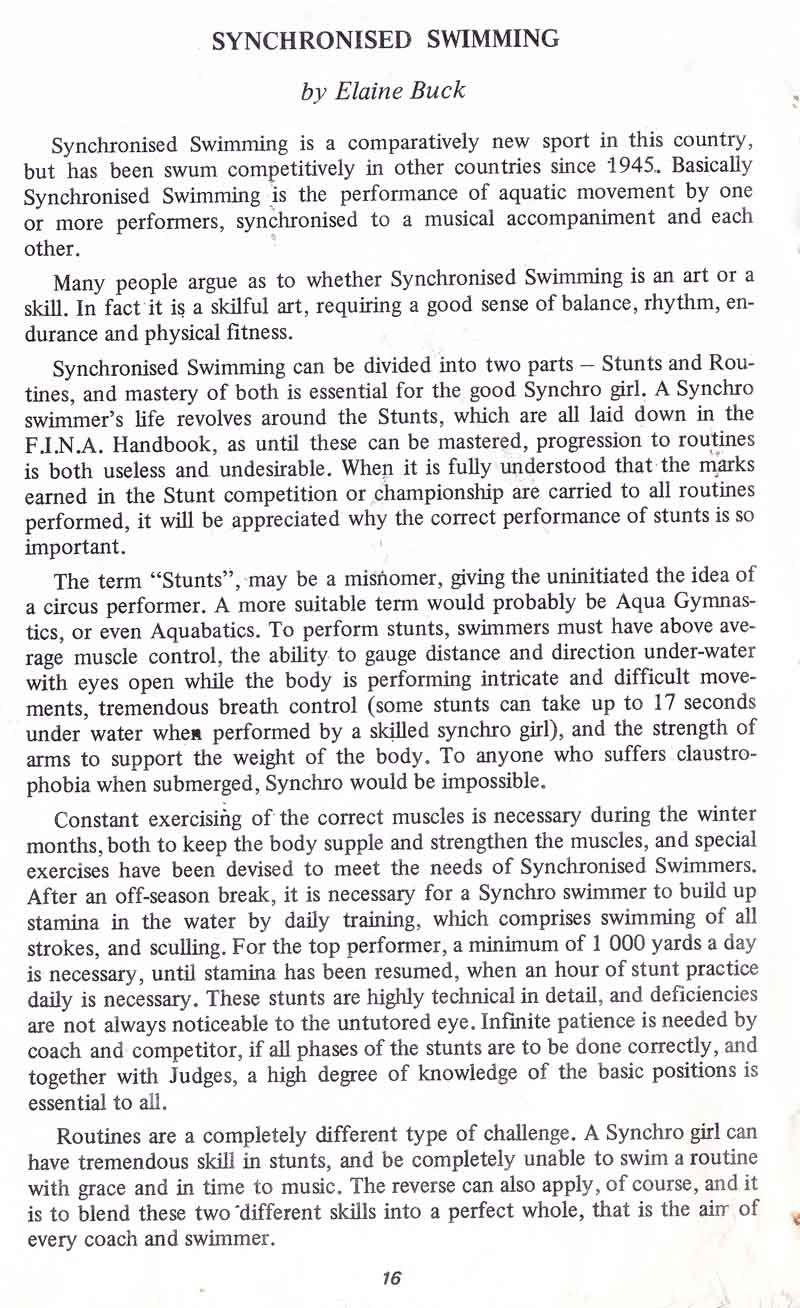
1973 Report 1
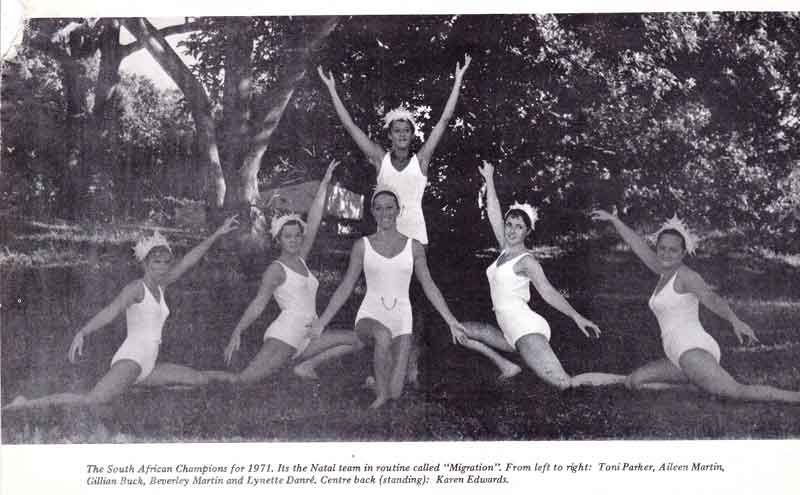
1973 Report 2
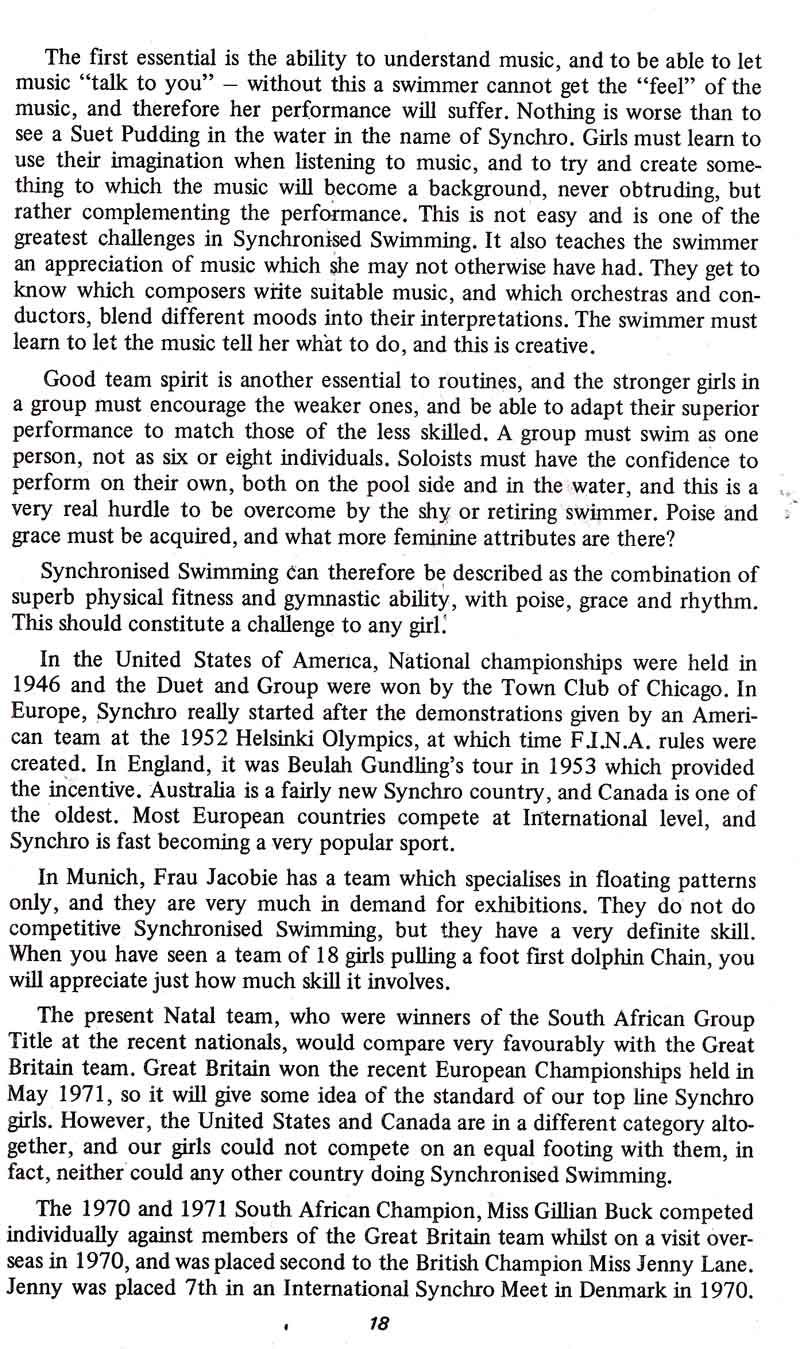
1973 Report 3
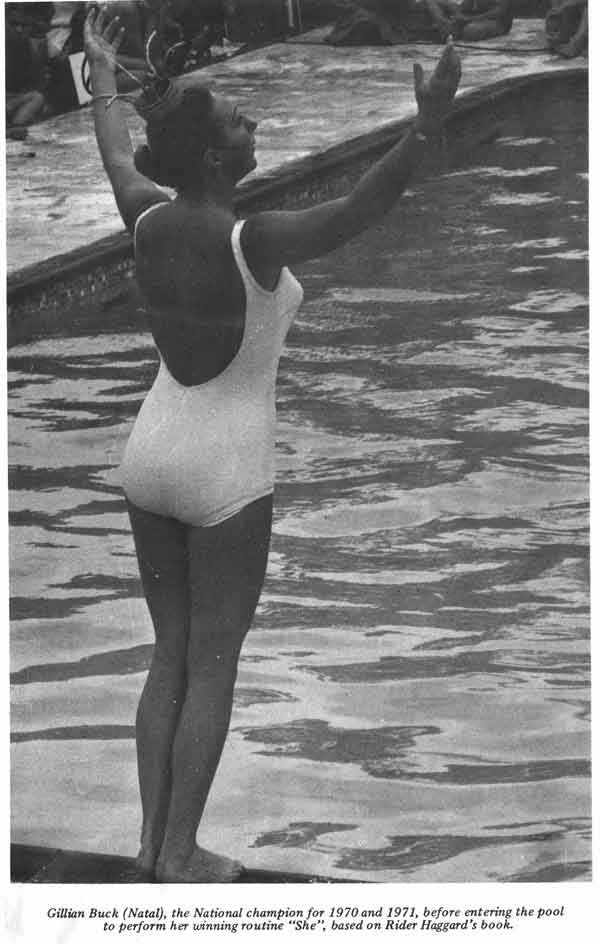
1973 Report 4
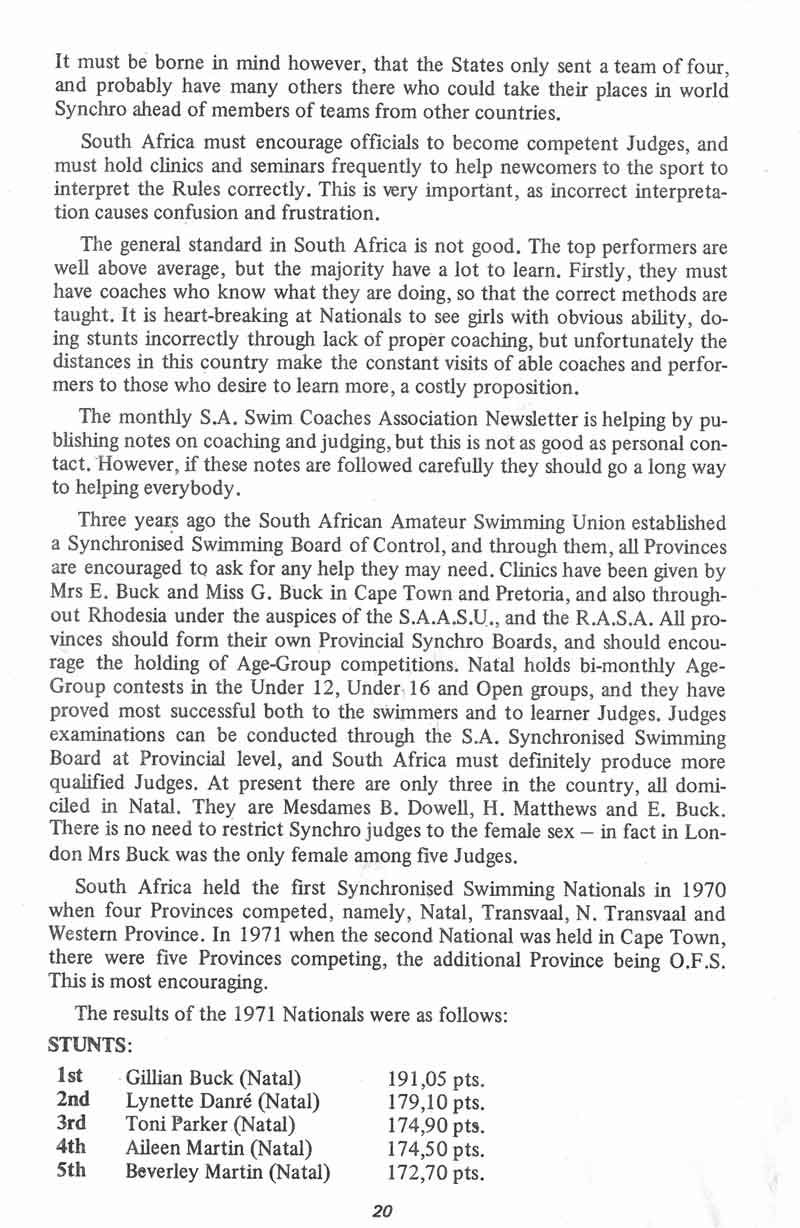
1973 Report 5
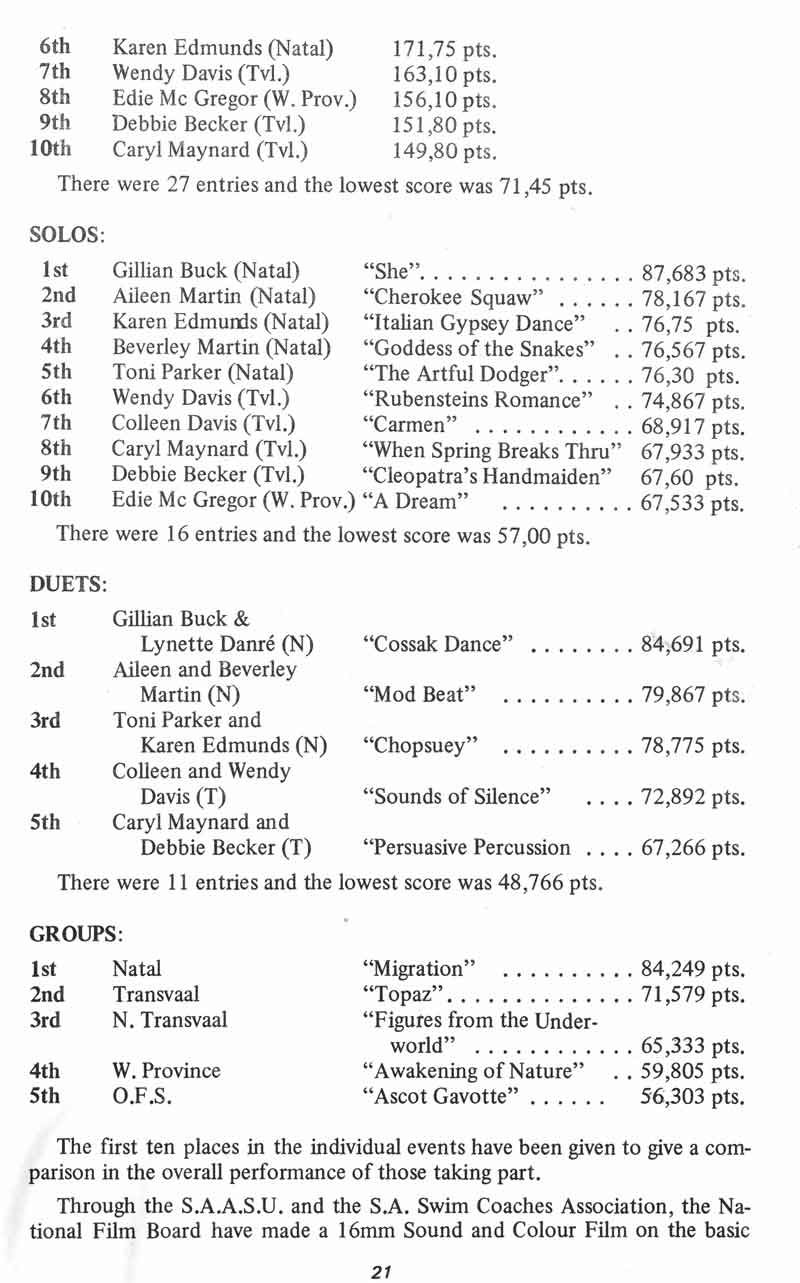
1973 Report 6
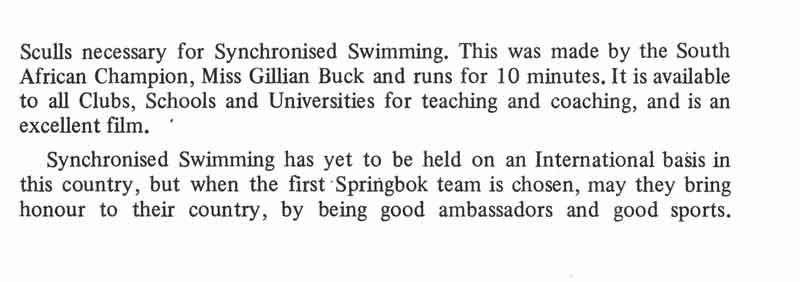
1973 Report 7
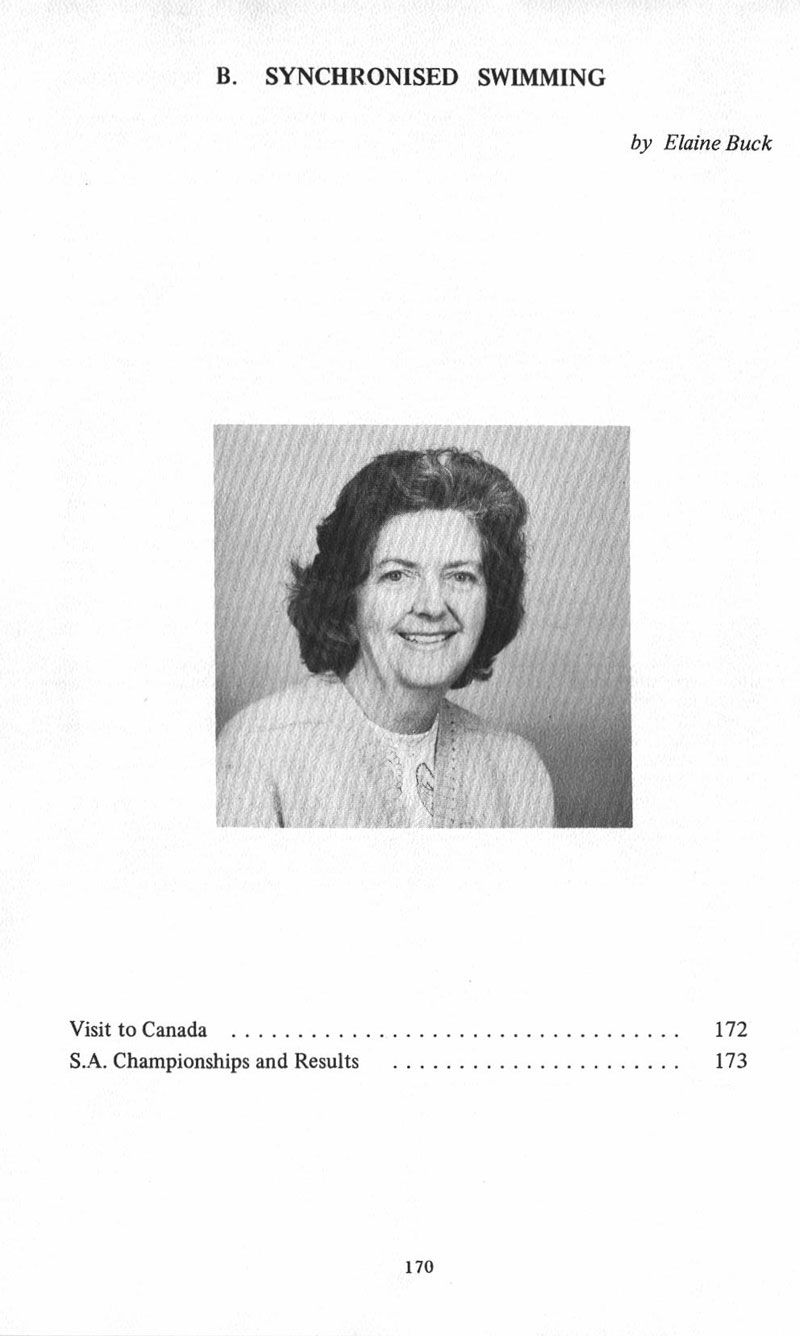
1973 Synchro Report 1
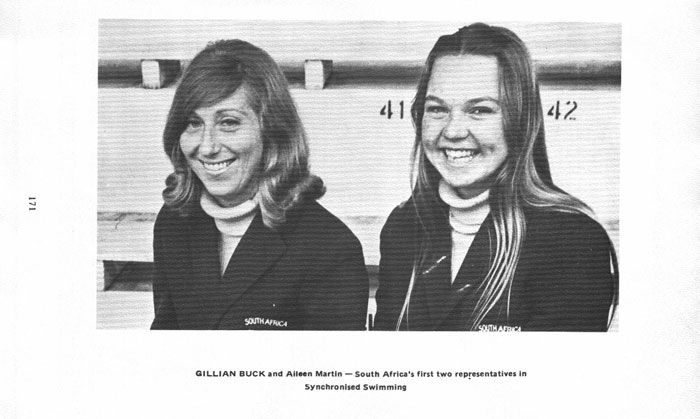
1973 Synchro Report 2
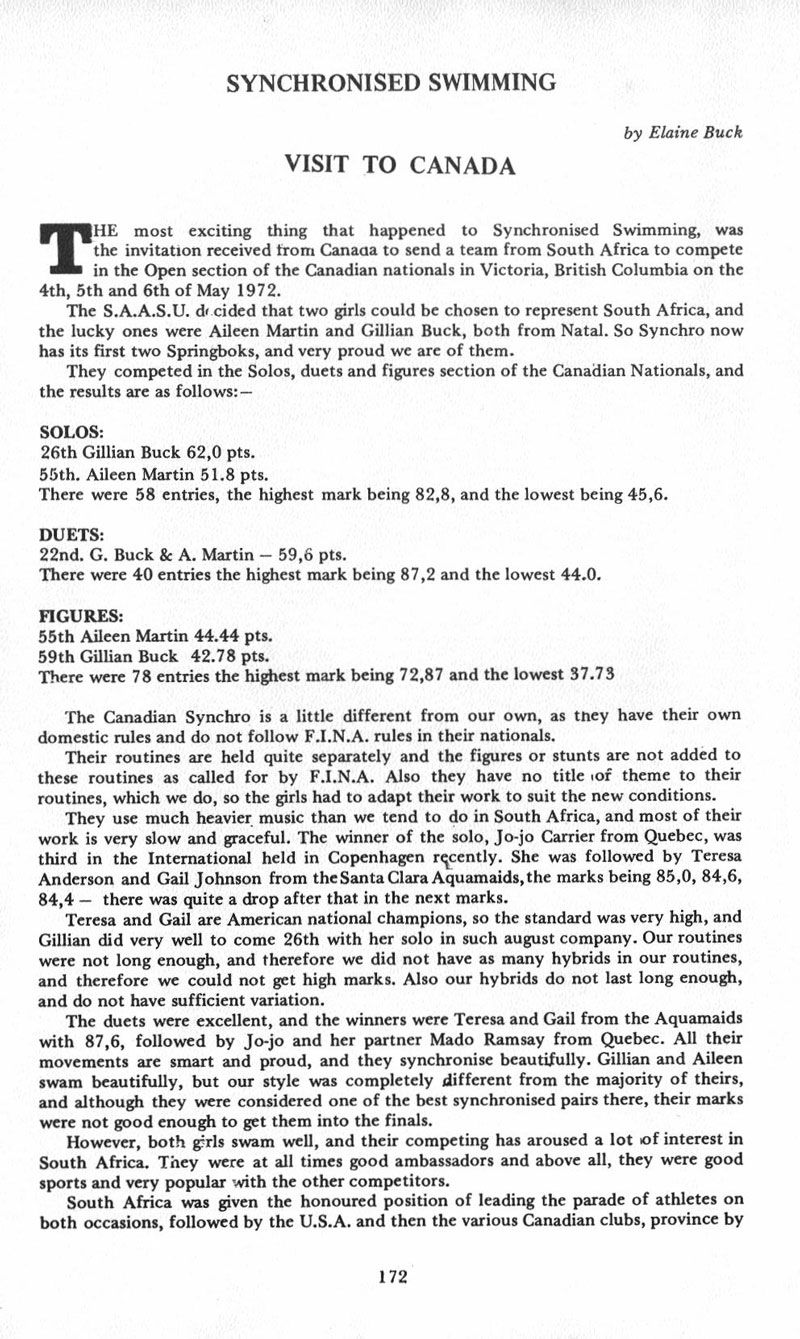
1973 Synchro Report 3
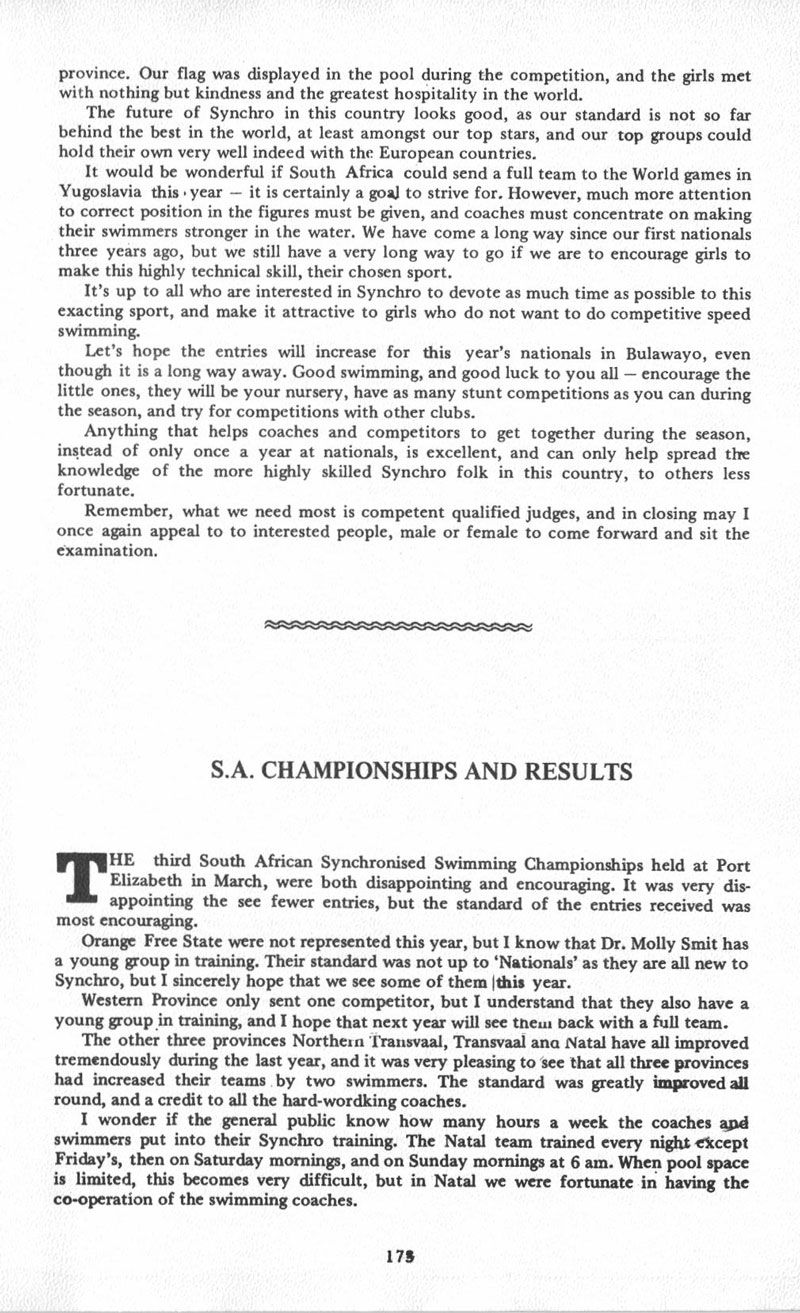
1973 Synchro Report 4
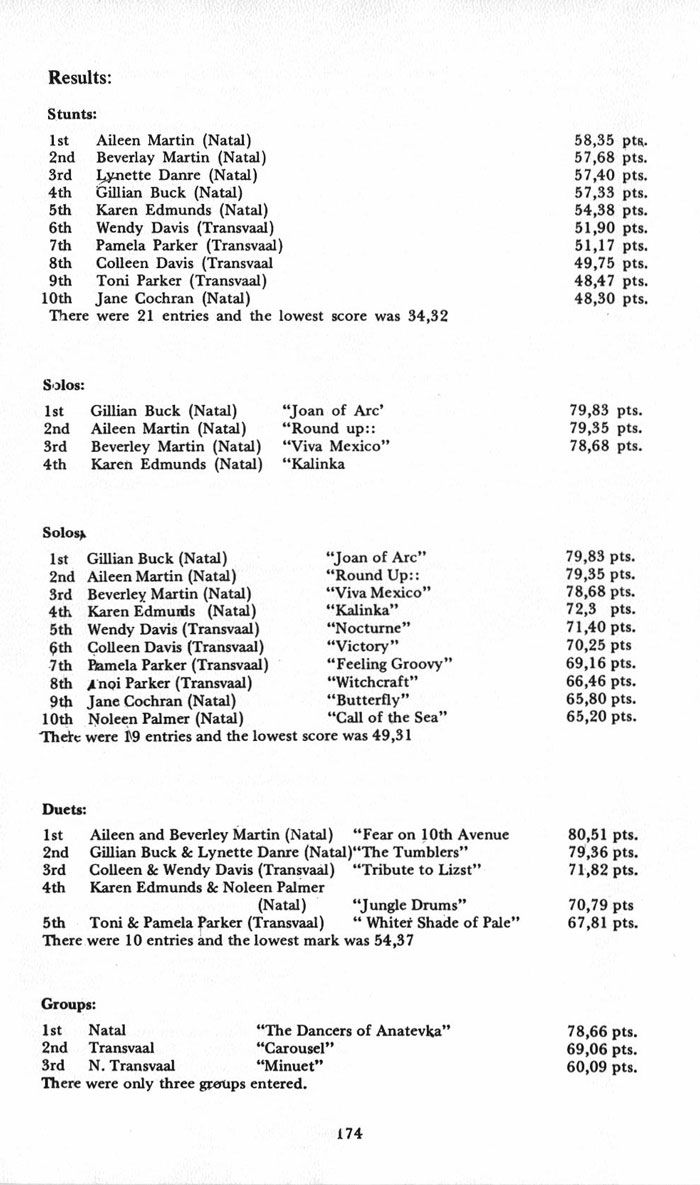
1973 Synchro Report 5
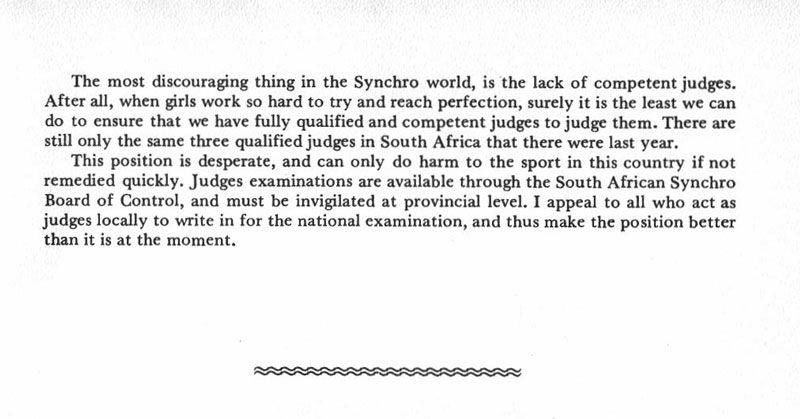
1973 Synchro Report 6
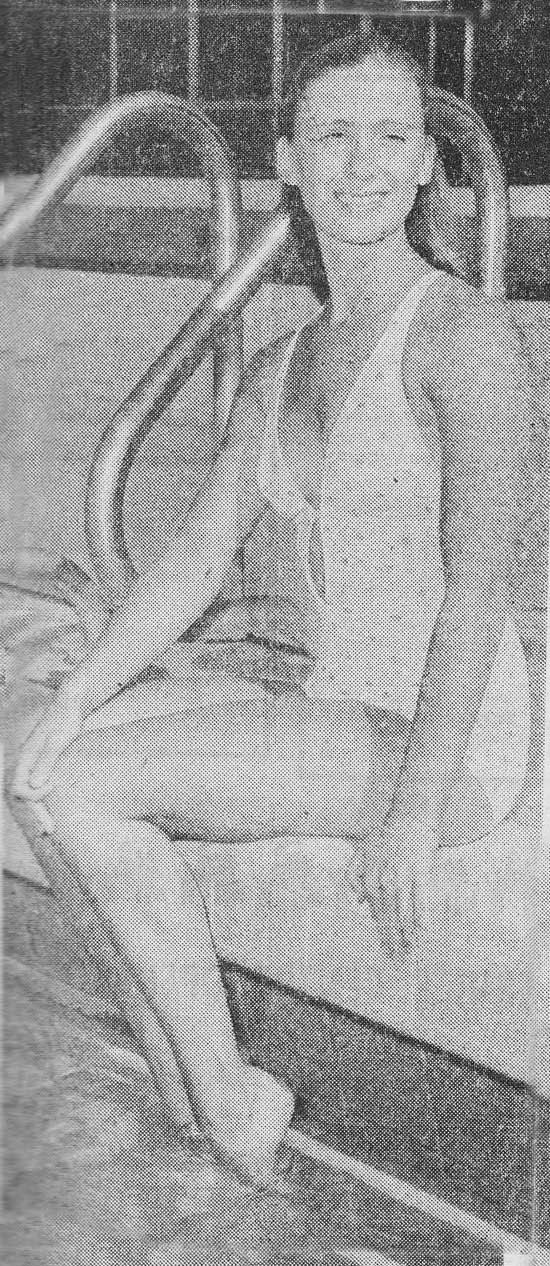
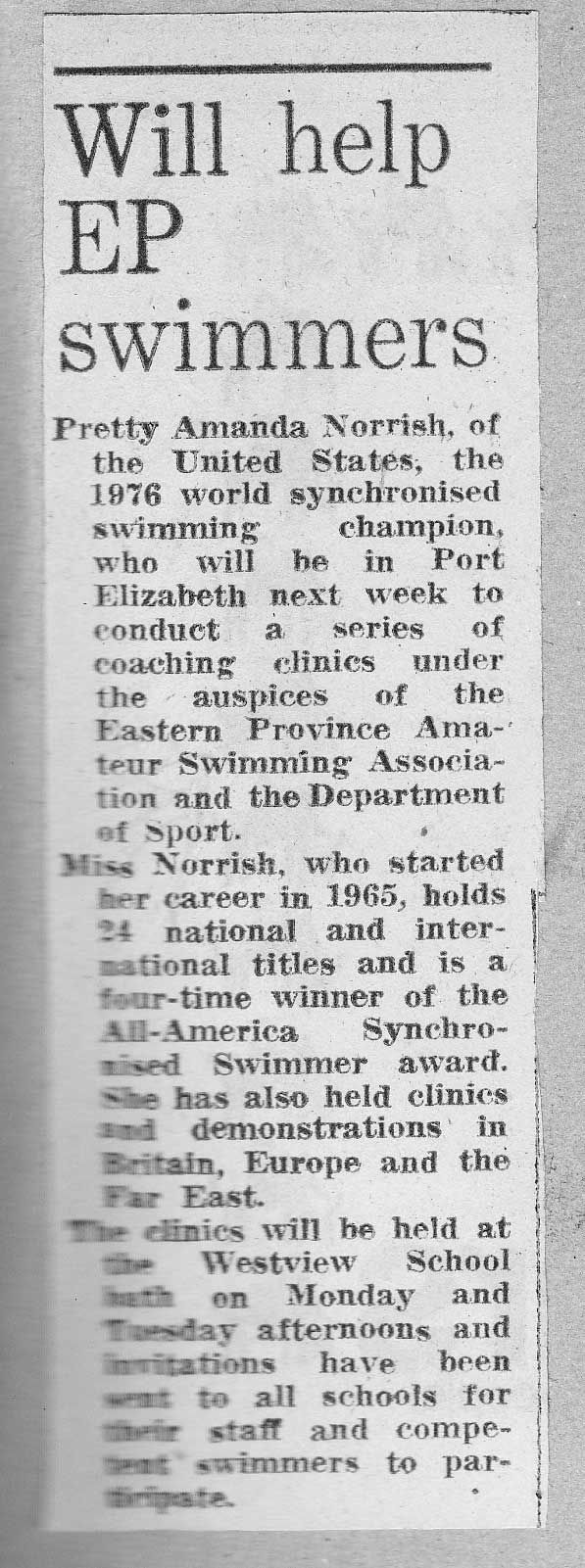
Amanda Norrish was an American world champion (1973 and 1975) synchronised swimmer who visited and lived in South Africa for a period in 1976-1977. She gave coaching clinics in South Africa and Rhodesia.
Other coaches who visited the country at that time included Marion Kane and Laurie Miller of the USA, Donalda Smith of Canada and Dawn Zajac of Great Britain.
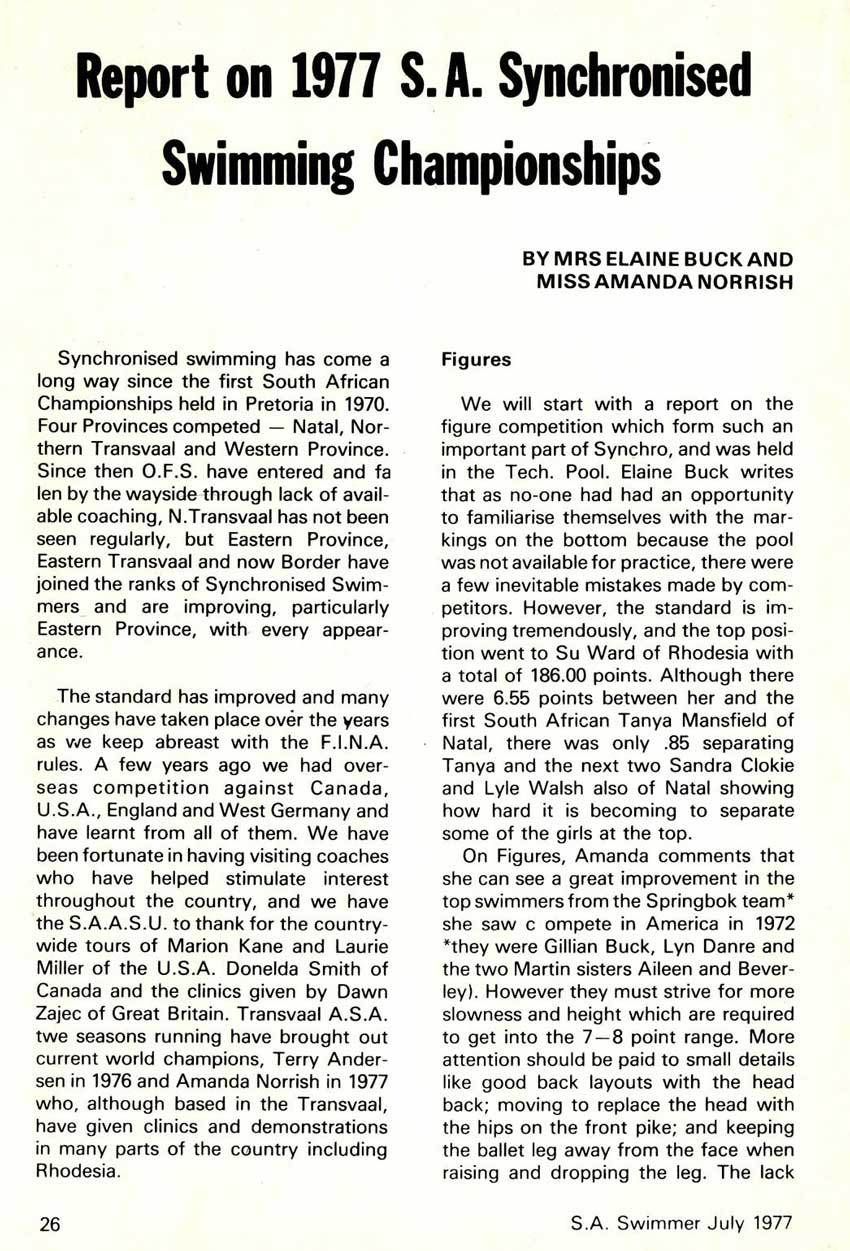

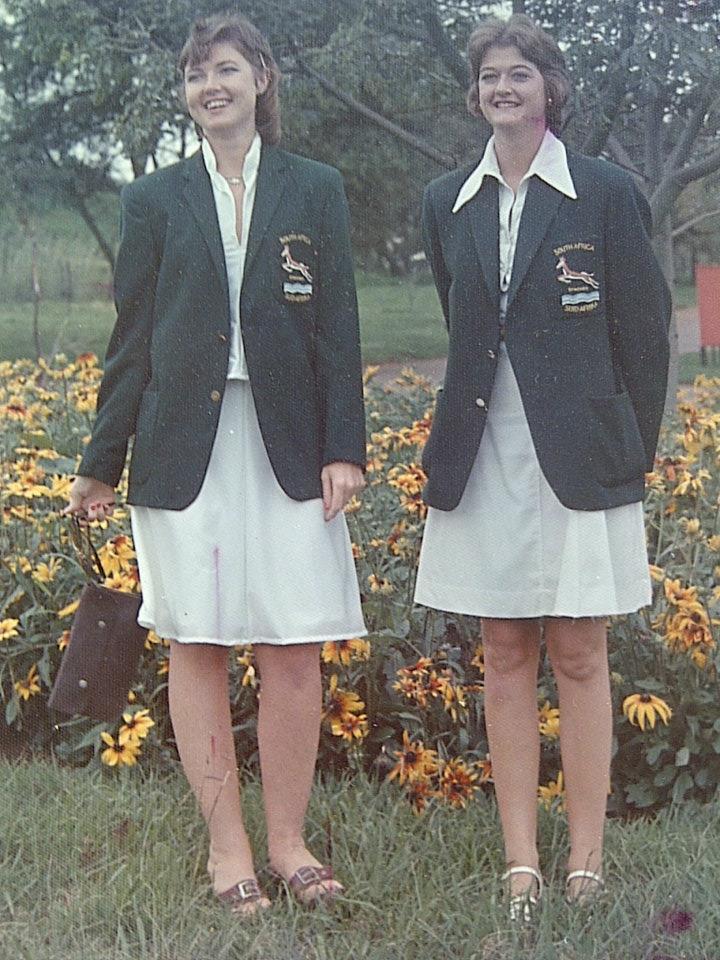
Natal synchronised swimming Springbok sisters Beverley and Aileen Martin
Cygnus Club in Durban is one of the top clubs in the country, offering synchronised swimming under the guidance of Barbara Dowell. Over the years the Cygnus synchronised swimmers have represented KZN at the SA Nationals event winning most of the top medals/trophies. Cygnus members have, over the years, represented SSA at various international events, including Olympic & Commonwealth Games. Earlier in 2008 Cygnus employed a Canadian Coach for 3 months to ensure the skill levels continued and the experience the girls gained during this time was invaluable. In June 2008 a Cygnus team of 7 members travelled to Singapore to compete in the Singapore 3rd National SS competition and brought home 4 gold medals and 1 silver medal. Many of the Cygnus members are representatives of the SA Nationals Junior and Senior teams. Cygnus has just returned from the 2008 National Age Group Championships and brought home the club trophy for the 23rd consecutive year running.
click here to see the Cygnus Centenary brochure
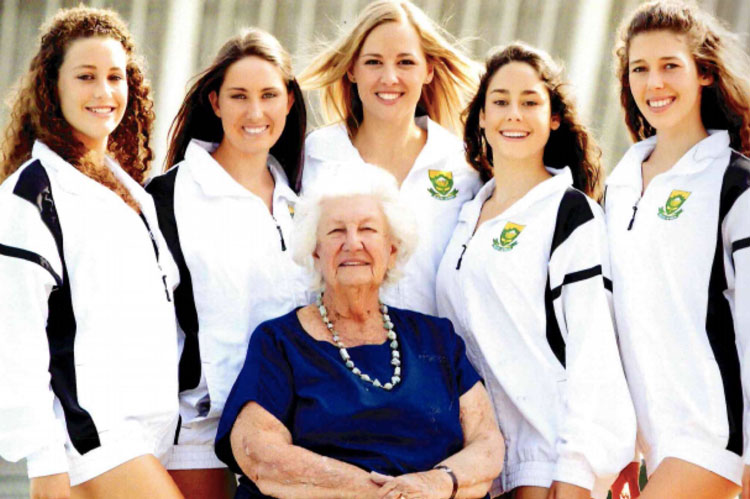
Cygnus coach Barbara Dowell with SA Synchro swimmers
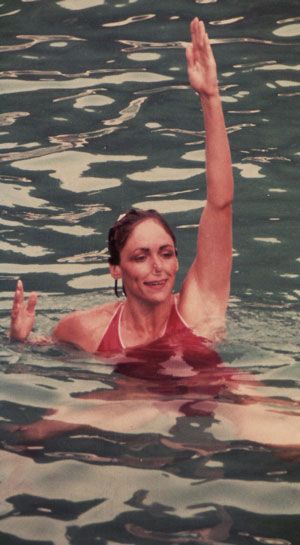
Transvaal Springbok synchro swimmer Kerry Woodhead.
Again But Better: South Africa Returns to the Olympics After 29 Years
22 July 2021
When Clarissa Johnston received a call from former teammate Laura Strugnell, she at first wasn’t really sure what to make of it. Strugnell was unequivocal: she wanted Johnston to come out of retirement to swim a duet with her in the hopes of being selected for the 2020 Olympic Games.
South Africa had not been represented at the Olympics in artistic swimming since 1992. For Tokyo, the nation had again earned a duet quota via the continental route at the 2019 World Championships. However, the federation had historically not accepted that quota and the athletes were convinced it would be the case again. After that summer, Strugnell decided to retire and move on.
In a random twist of fate a couple of months later, she found out while at work that South Africa actually would send a duet to Tokyo. She hadn’t been out for too long, but her former duet partner was already swimming with somebody else. Facing this once-in-a-lifetime opportunity, Strugnell thus had to quickly find a new partner.
A past national team member, Clarissa Johnston was also living and working in Cape Town. She had however completely stopped swimming in 2014. Fortunately, Strugnell made her point and convinced her to give it a try until the national trials a few weeks later. There, the winning duet would be the one selected for the Games.
A long and tough year later, Johnston and Strugnell, 30 and 29 years old respectively, won the South African trials. Coached by Vicky Drinkwater and two-time Egyptian Olympian Reem Abdalazem, they are now getting ready to fly to Tokyo in a few days. The Games will be their first international senior competition together.
Inside Synchro: Can you tell us about your respective careers in artistic swimming, and how your paths eventually crossed?
Laura Strugnell: I started synchro when I was five. I competed in every World Championships between 2011 to 2019. After these last ones, it didn’t seem that South Africa was going to take the Olympic quota, so I retired. I found out in February of 2020 that they were taking it, and that they were going to hold trials. I then contacted Clarissa, and here we are together (smiles)…
Clarissa Johnston: I started when I was 12. I actually swam with Laura on the 13-15 national team in 2005. Then in 2007, I was on the senior national team. We were competing against Egypt for the qualifying spot at the CANA Africa Olympic Trials. Reem was also there swimming for Egypt. After that, I went to Lindenwood University in the U.S. until 2013. I actually swam with Reem on the A team during the 2010-2011 season, and retired shortly thereafter. I went back to South Africa, and swam for a recreational club in 2014, more for fun. But I couldn’t fit that in with full-time work so I stopped. Then, Laura messaged me at the start of 2020, and was like, “Do you… want to do synchro again (laughs)?”
IS: Had you continued swimming or done any other sports in the meantime?
CJ: Not really. I did some trail running, and one open water swim, but nothing compared to normal synchro training. I hadn’t even continued stretching my splits, but why would I!? It was quite a shock to my body to come back and do it all again.
IS: And Laura, how did you find Clarissa?
LS: After I decided to retire in 2019, my old duet partner started swimming with another girl. Obviously, they were already together, so there wasn’t really an opportunity to go back and be with her again. So, I had to find a new duet partner. I did ask a few people that I knew, even my sister who used to do synchro, but that led nowhere. Eventually, I found out that Clarissa was living in Cape Town too. So, I just took the chance and asked her. I was very excited when she said yes.
IS: Did you have to do a lot of convincing for her to agree to return to elite after six years?
LS: Well, the word “Olympics” did help a little (laughs)! She did say that she needed to get back in the pool and try a few things before she would consider it. But I don’t know how much of an option I really gave her…
CJ: Back then, it was also only 10 weeks until the qualifiers. I was like, “You can do anything for 10 weeks.” At the time, we were the underdogs and the mindset was completely different. I was just thinking, “Let me help Laura out, do these two routines at nationals, and then we will see.” Her previous partner was in the duet we would be up against. They were almost the expected champions in a way. People didn’t think that Laura would find someone else. But then with Covid-19 delaying the Olympics and our trials, it gave us much more time to catch up and try to pull ahead.
LS: Yes, to have that extra year was really a blessing in disguise for us. At the time, we would have only had a few weeks together before trials. Maybe we wouldn’t even have made it back then…
IS: How did you manage to catch up, especially in such a complicated year?
LS: We took every opportunity that we could. Honestly, even though I didn’t take such a big break from synchro, this is the hardest I’ve ever trained in my whole career.
CJ: Lockdown was very strict here, to the point where you couldn’t even leave your house to walk your dog. We did a lot of workouts together on Zoom, and also with our coach Vicky who is based in Johannesburg. We really did anything we could find, any Instagram Live workouts or some of the U.S. team workouts on YouTube. As soon as pools reopened, we went even if we could only access the pool that was one meter deep. We worked so hard because we knew we were behind. There was never a time where we could be comfortable and take it easy.
IS: Then last April, you won both duet events at the South African trials. How did you feel, and when you realized you would indeed go to the Olympics?
CJ: It was really surreal. We actually had to wait two days to get our results because we had international judges, and they were given a few days to score. I was home alone when the email finally came through. It was amazing. For the Olympics, we still had to wait until June 24. The South African Olympic Committee (SASCOC) wanted to announce it live on national television. So, we actually waited two months until we finally got named. It was a very long wait, and we didn’t want to say much until we had it officially, especially with all the uncertainty this year. In the end, we were all together watching it at our coach’s house, so that was obviously awesome.
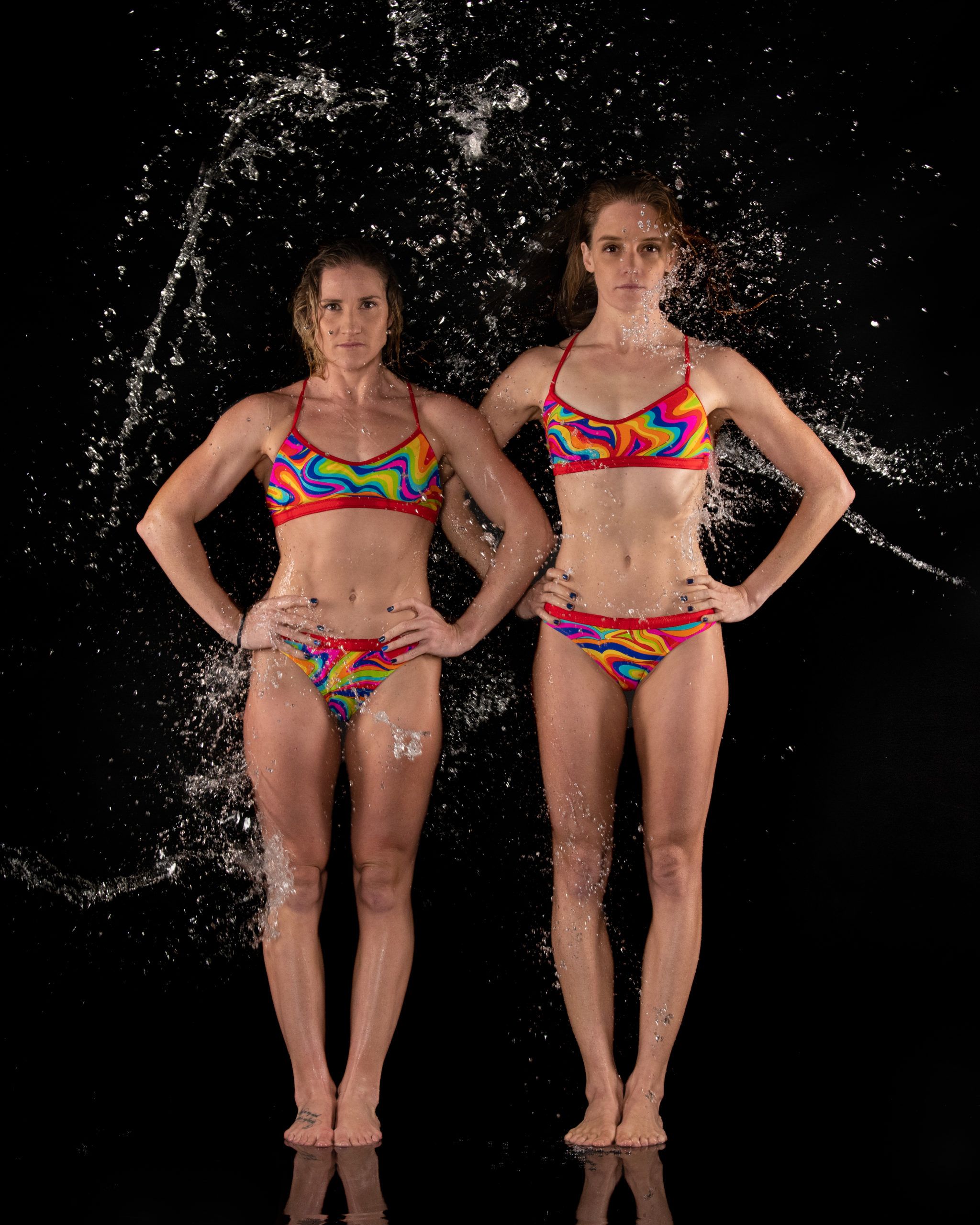
Swimming SA could find itself in hot water over its conduct
31 Aug 2024
It has refused to divulge the results of its quadrennial annual general meeting or the legitimacy of its executive committee candidates.
Swimming South Africa (SSA) held its quadrennial annual general meeting on 25 August 2024 and elected its executive committee for the next four-year term. However, several members who were nominated to be elected have served more than the three-term (12-year) limit set out by the swimming body’s constitution.
The results of the meeting have not been made public yet. SSA has ignored all Daily Maverick’s requests for transparency about the results of the meeting and the legitimacy of its nominees.
SSA president Alan Fritz once again contested the presidency, but completely unopposed. He has served as a member of the executive committee, in one capacity or another, since 2004, for a total of ve consecutive terms (20 years).
An additional four years will see him double the maximum number of terms stipulated by the constitution. Article 6.2.3 reads: “The term of oce for all executive members will be limited to three consecutive periods.” Jace Naidoo, the vice-president, was nominated to serve an additional term in the same position. He has been on the executive committee since the unification of SSA in 1999. He was president from 2004 until 2016 and vice-president from 2016, and is aiming to serve until 2028.
In 2004, Naidoo said in a parliamentary meeting that SSA had a four-year leadership cycle, and it tried to ensure that presidents served no more than two terms in order to encourage training in leadership. Instead, however, it seems the same leaders are moving from one seat on the committee table to the next, contrary to the constitution of World Aquatics, which should at least be a guiding document for SSA.
Article 18.4 of World Aquatics’ constitution specifies: “If an executive member (e.g. a president) is elected to a new position in the executive (e.g. as treasurer), any previous term served in the executive (e.g as vice-president) is counted as part of the individual’s overall term of oce…”
Also included in this re-election muddle are Zikie Molusi and John Ellis, who were up for nomination as deputy president and treasurer, respectively, despite both having served on the committee since 2012 (three terms). It appears that these nominations were in breach of both Aquatics’ constitutions.
Queries
Prior to the quadrennial annual general meeting, Matt Kemp, a registered member of SSA and director at law rm Becker Kemp Attorneys, sent a letter to the body disputing the eligibility of the aforementioned quartet to be allowed to be nominated to the executive committee.
In response, SSA CEO Shaun Adriaanse noted that Becker Kemp Attorneys is not a member of SSA. “We take note of your correspondence as attached,” he said in an email. “Kindly note that after verification we can confirm that Becker Kemp Solicitors Attorneys are not capitated [sic] as a member of Swimming South Africa.”
But Kemp is a registered member of SSA and the complainant in this matter. He sent the letter in his personal capacity. SSA is apparently playing semantics instead of addressing the issue at hand: how these executive members are continually seeking re-election apparently in breach of SSA’S own constitution. SSA members who oppose the current leaders were not invited to the quadrennial annual general meeting.
Going silent
SSA and Fritz has not responded to any queries from Daily Maverick regarding the legitimacy of the members of their executive committee. Attempts to ascertain who was elected to the executive committee were also unsuccessful. The only response Daily Maverick received was a Whatsapp message from Fritz on 26 August stating that he would phone back at a later stage, which he did not do.
Although they can ignore the media (but questions and probing won’t stop), the leaders of SSA are likely to face a high court review of their conduct brought by Becker Kemp Attorneys. If there is nothing untoward in their conduct, why not show SSA’S constituents and the media the clauses in its constitution – or in any other documentation – which allow board members to serve upwards of three terms?
A familiar pattern
This method of dealing with problems is not new for SSA. In February, Daily Maverick reported on SSA’S decision not to send the national men’s and women’s water polo teams to the Paris Olympics. Adriaanse said SSA did not believe that either team was good enough to win a medal at the Games and therefore should not go – despite qualifying as Africa’s best. He did not respond to further queries. Current and former water polo athletes and coaches told Daily Maverick they were mistreated by SSA after the publication of the story.
Adriaanse, however, chose not to respond to any of the accusations. Daily Maverick asked for a high-performance plan for water polo from SSA for the next Olympic cycle to ensure the team would be deemed “ready” for Los Angeles 2028. There has been no response to this request, which was made at the end of February.
Daily Maverick’s correspondence with former women’s national water polo coaches Sarah Kravitz and Delaine Mentoor – who were removed from their positions without clear reasons – showed that SSA is accustomed to cutting communication. A stuttering state SSA has had an error-ridden record with the current executive committee at the helm. Breaststroke swimmer Lara van Niekerk (21) swam the qualifying times for the 2024 Paris Olympic Games at nationals in 2023, which falls in the Olympic qualifying period.
But SSA made a clerical error that meant the nationals was not registered as an ocial Olympic qualifying event. Van Niekerk was a medal hopeful in the 100m breaststroke – her personal best time is only just o what teammate Tatjana Smith swam to take gold in Paris.
Artistic duo Laura Strugnell and Jessica Hayes-hill’s chances of competing at the Olympic Games were also ripped out from under them after they were sent home from the swimming World Championships in Doha – an Olympic qualifying tournament – at the start of the year.
SSA did not provide a reason for their dismissal. The athletes appealed the decision and won their appeal. This follows the decision not to send the men’s and women’s water polo teams to the Olympics for dubious reasons after setting an arbitrary qualifying standard at the World Championships. Athletes in both teams claimed to be unaware of it until after the fact.
SSA’S executive committee and the sporting disciplines it serves look likely to have another four-year period together, despite their own constitution not supporting it. SSA is apparently playing semantics instead of addressing the issue at hand: how these executive members are continually seeking re-election apparently in breach of SSA’S own constitution
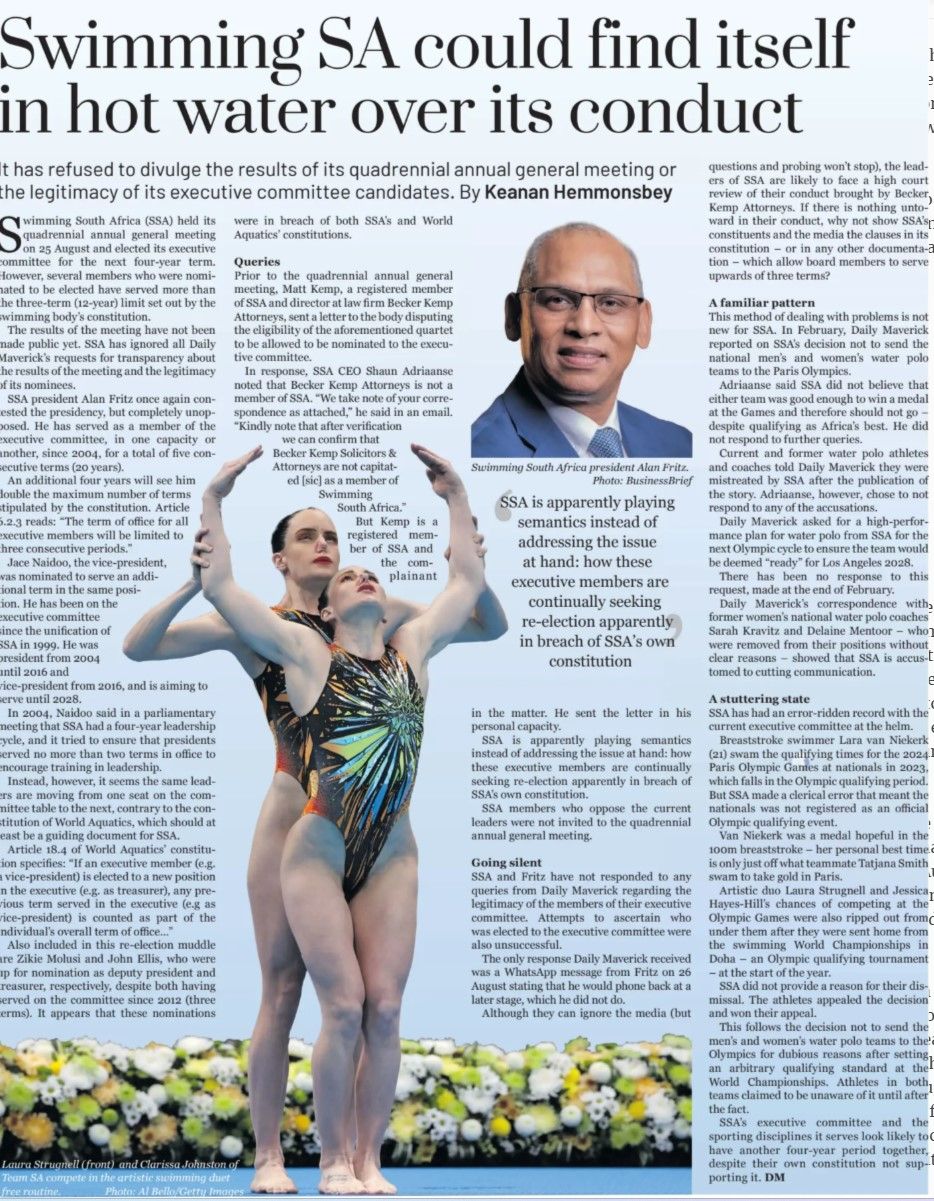

Kerry Norden
FINA World Championships - 2011, 2013, 2015
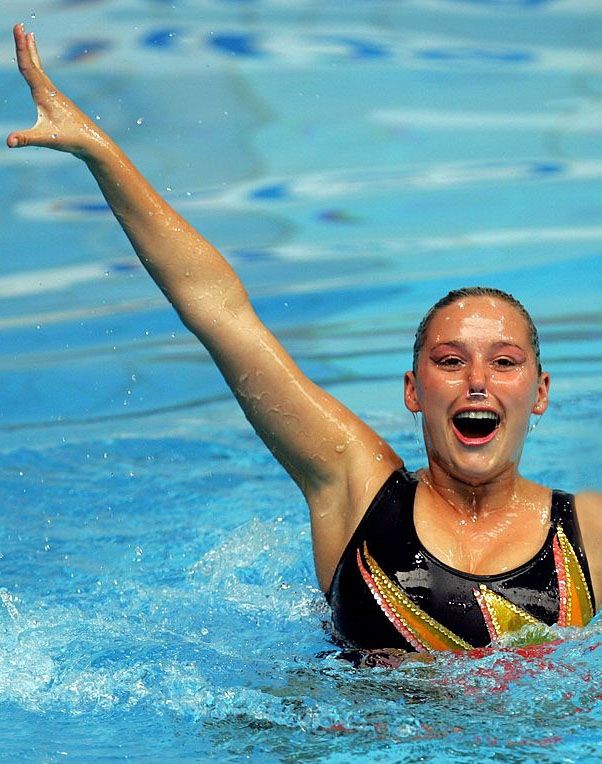
Shannon Crowder
18th Commonwealth Games 2006 and 2011 FINA World Championships
Ayrton Sweeney
In June 2022 history will be made in the artistic swimming (formerly synchronised swimming) pool as Ayrton Sweeney becomes the first man to represent South Africa in the sport. Having represented the country in swimming for numerous years, Sweeney made the switch a few months ago and will compete in the mixed duet with Laura Strugnell.
“I think Ayrton can vouch for the fact that he had no idea what he got himself into until he was in because it was very different to the training and competition prep he was used to, but he has taken this challenge and succeeded,” said Strugnell, who represented the country at the Tokyo Olympics last year.
“I love swimming with him, I laugh for almost all of the session and I don’t think there is another male swimmer I would rather swim with,” she added.
The swimming programme in Hungary will take place from 18-25 June with the diving being contested from 26 June-3 July. Open water swimming will take place from 26-30 June. Artistic swimming will be contested from 17-25 June with the men’s and women’s water polo tournaments being played from 20 June-3 July.
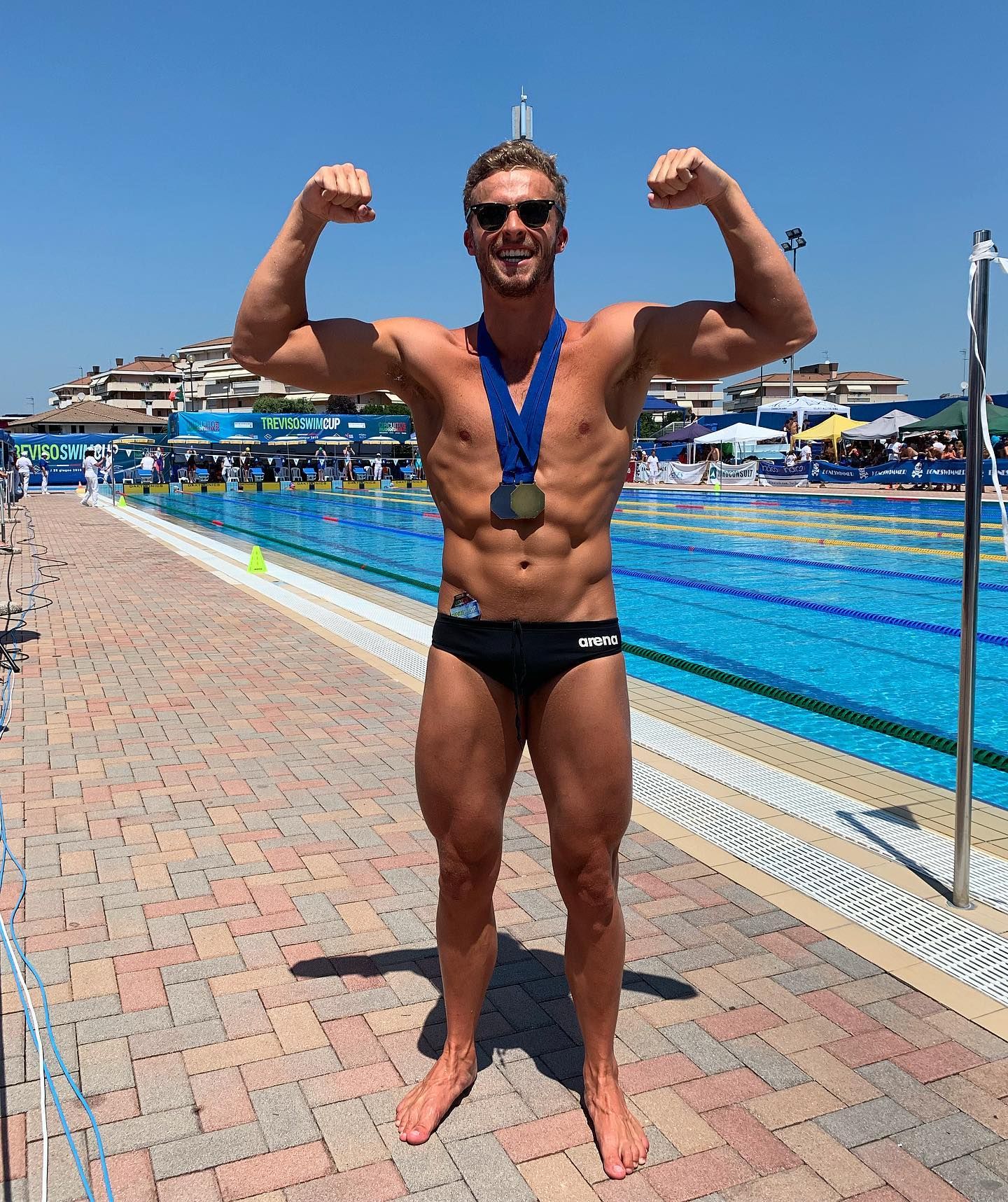
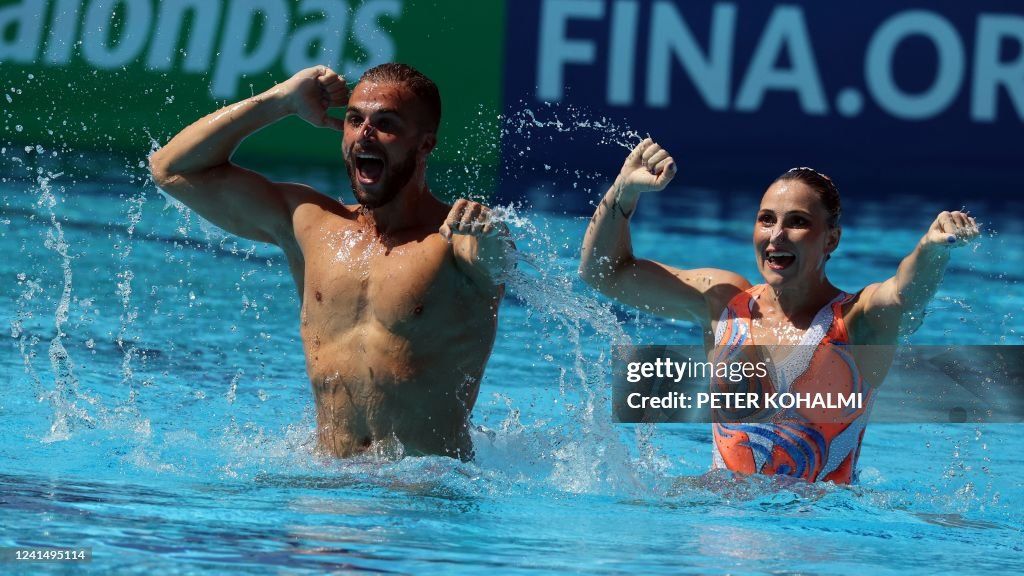
South Africas Laura Strugnell and South Africas Ayrton Sweeney compete in the preliminaries for the Mixed Duet Free artistic swimming event during the Budapest 2022 World Aquatics Championships at the Alfred Hajos Swimming Complex in Budapest on June 24, 2022.
